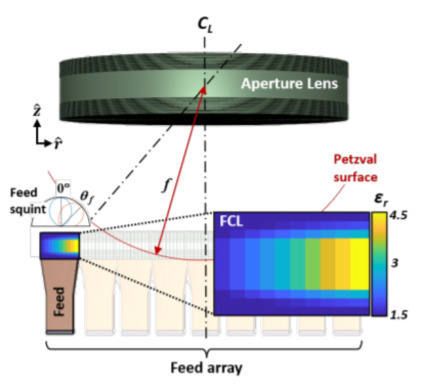Compound Lenses for Improving Beam-Scan Performance of Reflector and Lens Antennas
Tech ID: 20-044
Inventor: Dr. Jonathan Chisum
Date added: June 24, 2020
Overview
An aperture lens and feed-correction lens system with lower scan loss and power consumption for reflector and lens antennas in wireless communications.
Technology Summary
Lens antennas are commonly utilized in 5G networks and satellite communications for transmission and reflection of wireless signals. Lens antennas typically achieve beam scan by switching between various feed elements distributed across a focal plane below the lens. However, excessive scan-loss occurs toward the edges of the lens at extreme scan angles. Improvements in antenna signal quality can be achieved by beam squinting, phase predistortion, and other methods, but current state of the art solutions face a trade-off between power consumption of the system and antenna signal quality. Ultimately, reflector and lens antennas in wireless communications would benefit from preventing scan loss and reducing the amount of power required to run the system.

Researchers at the University of Notre Dame have recently developed a compound antenna system comprising an aperture lens and feed-correction lenses (FCL) at every feed element for lens and reflector antennas in 5G and satellite communications. The FCL design decouples the beam correction from that of the aperture lens, allowing for a greater degree of optimization. The system is uniquely designed for each feed location in order to squint the feed beam toward the center of the lens, reducing spillover. The feed phase is predistorted to correct aperture phase distortion, improve efficiency, and create sidelobes (local maxima of antenna signal in undesired directions). The Compound Lenses for Improving Beam-Scan Performance of Reflector and Lens Antennas developed by the University of Notre Dame overcomes the tradeoff between antenna signal quality and power consumption, as one is optimized without compromising the other.
Market Advantages
• Compared to Typical Lens Antenna:
- Increased quality (high gain but low side lobes)
- Increased range – lower scan loss
• Compared to Phased Array:
- Lower power consumption
- Lower manufacturing costs
• Compared to Other Solutions:
- Focal points are not restricted
Market Opportunity
$1.57 M US Market – 5G networks + satellite communications
Intellectual Property
Patent Pending
Technology Readiness Level
TRL3 - Experimental Proof of Concept
Contact
Richard Cox
rcox4@nd.edu
574.631.5158